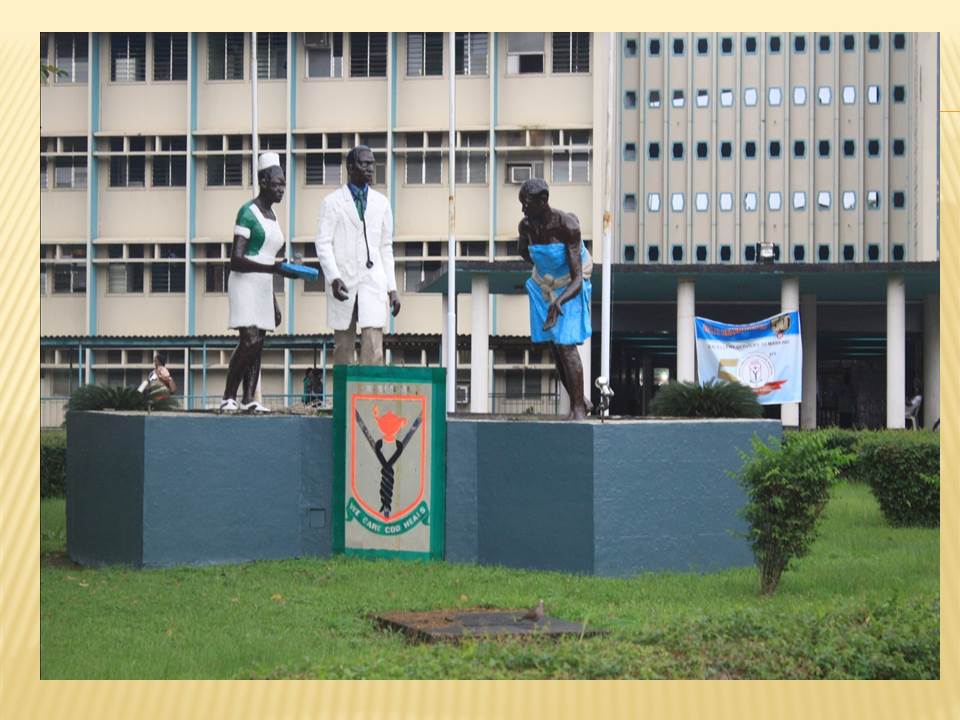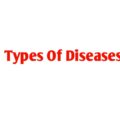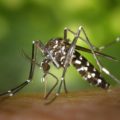What is a Notifiable Disease?
A notifiable disease refers to diseases which the law or regulations mandate that are reported to health or government authorities upon diagnosis or possible sightings. They are closely monitored or priority diseases and the collation of data and other vital information about them allows the authorities to monitor them and provide early warnings of possible outbreaks. Diseases to be notified to WHO are outlined in the International Health Regulations but most countries have their own list of nationally notifiable diseases. Making a disease legally ‘notifiable’ by doctors and health professionals allows for intervention to control the spread of highly infectious diseases such as influenza, poliomyelitis or yellow fever. In less infectious conditions it improves information about the burden and distribution of disease.
Disease surveillance is the continuous scrutiny of the occurrence of diseases and health-related events to enable prompt intervention for the control of diseases. It involves the ongoing systematic collection, collation, analysis and interpretation of data on disease occurrence and public health related events and the dissemination of the information obtained from such data for prompt public health action. However, disease notification involves the official and timely reporting of the occurrence of specific diseases and conditions to designated public health authorities by clinicians and other health personnel for action using designated reporting tools.
Disease notification is an important source of data collection for an effective and efficient disease surveillance system. Disease surveillance and notification (DSN) have been recognized as an effective strategy for the prevention and control of diseases most especially epidemic prone diseases. It is crucial to note that disease outbreaks do not give notice before their occurrence nor do they respect the borders of nations. When they eventually occur, they are likely to spread like wildfire and often result in high morbidity and case fatality rate with consequent economic impact. An effective and efficient disease surveillance and notification system allow early detection of disease outbreaks that will prompt intervention for the reduction of morbidity and mortality that may result from the epidemics of these infectious diseases. Levels of disease surveillance and notification can be individual, local, national and international. National disease surveillance and notification system often depend on effective district/Local Government Area (LGA) disease monitoring and control mechanisms with the clinicians actively involved.
List of Notifiable Diseases in Nigeria and its channel of Notification
Disease monitoring is the core function of Integrated disease surveillance and response(IDSR) specialists all over the world. IDSR priority diseases in Nigeria are classified into three categories namely:
1. Epidemic prone diseases in Nigeria
2. Diseases targeted for eradication and elimination in Nigeria
3. Diseases of Public Health Importance In Nigeria
Channels of Reporting Notifiable Diseases In Nigeria
The IDSR strategy in Nigeria involves the collection of information on notifiable diseases from a single focal point at each level (Community, health facilities, LGA, State and Federal) The main focus of the IDSR system in Nigeria is the LGA where a focal person (s) is assigned to the schedule of collecting and recording all information related to notifiable diseases in a local government area. The officials liaise with all health facilities in the local government (primary, secondary and tertiary) to collate and document findings and reports which are often directly supervised by the director of public health in the local government.
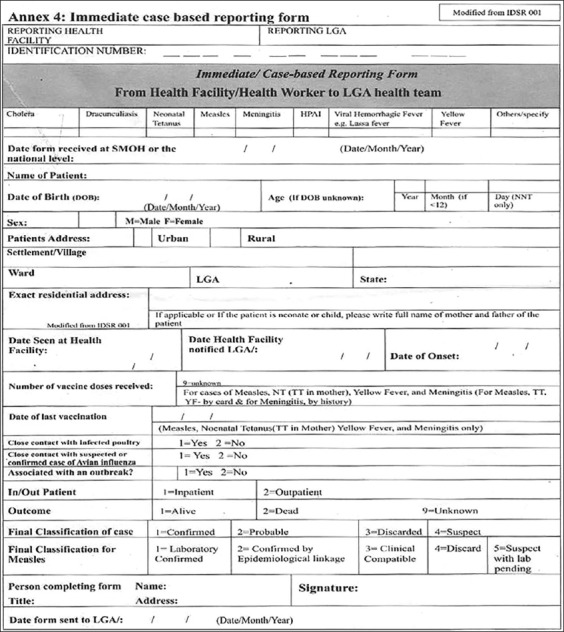
The Integrated Disease Surveillance and Response (IDSR) 001A form is used for immediate case-based reporting of notifiable diseases in Nigeria, when duly filled it should be sent immediately to the Local Government Area (LGA) Disease Surveillance focal person or team for documentation and possible action.
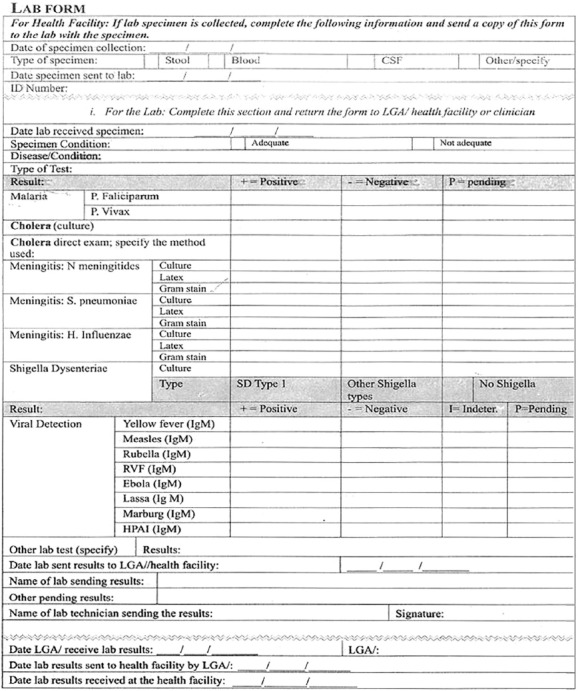
See Breakdown and Pdf Download Link below
Acute haemorrhagic fever syndrome
Suspected case: Acute onset of fever of fewer than 3 weeks duration in a severely ill patient AND any 2 of the following; haemorrhagic or purpuric rash; epistaxis (nose bleed); haematemesis (blood in vomit); haemoptysis (blood in sputum); blood in stool; other haemorrhagic symptoms and no known predisposing factors for haemorrhagic manifestations.
Confirmed case: A suspected case with laboratory confirmation or epidemiologic link to confirmed cases or outbreaks.
Note: During an outbreak, case definitions may be changed to correspond to the local event.
Acute viral
hepatitis
Suspected case: Any person with acute illness typically includes acute jaundice, dark urine, anorexia, malaise, extreme fatigue, and right upper quadrant tenderness. (Note: infected children are often asymptomatic.)
Confirmed case: A suspected case that is laboratory confirmed Adverse events following immunization
(AEFI)
A medical incident that takes place after immunization, causes concern and is believed to be caused by the immunization
Anthrax
Suspected case: Any person with acute onset characterized by several clinical forms which are:
(a) Cutaneous form: Any person with skin lesion evolving over 1 to 6 days from a papular through a vesicular stage, to a depressed black eschar invariably accompanied by oedema that may be mild to extensive
(b) Gastro-intestinal: Any person with abdominal distress characterized by nausea, vomiting, anorexia and followed by fever
(c) Pulmonary (inhalation): any person with brief prodrome resembling acute viral respiratory illness, followed by rapid onset of hypoxia, dyspnoea and high temperature, with X-ray evidence of mediastinal widening
(d) Meningeal: Any person with acute onset of high fever possibly with convulsions, loss of consciousness, meningeal signs and symptoms; commonly noted in all systemic infections, but may present without any other clinical symptoms of anthrax. AND has an epidemiological link to confirmed or suspected animal cases or contaminated animal products
Confirmed case: A confirmed case of anthrax in a human can be defined as a clinically compatible case of cutaneous, inhalational or gastrointestinal illness that is laboratory-confirmed by:
(a) isolation of B. anthracis from an affected tissue or site;
or
(b) Other laboratory evidence of B. anthracis infection based on at least two
supportive laboratory tests.
Note: It may not be possible to demonstrate B. anthracis in clinical specimens if the patient has been treated with antimicrobial agents.
Asthma Any person who presents with chest symptoms (including cough, breathlessness
and/or wheezing, often at night) that come and go, vary from day to day, and especially if they cause the patient to wake and even to rise at night, should be suspected of having asthma. If after careful examination no other cause is found and the symptoms persist for some period of time, asthma should be considered.
Buruli ulcer (Mycobacterium ulcerans disease)
Suspected case: A person presenting a painless skin nodule, plaque or ulcer, living or
having visited a BU endemic area.
Confirmed case: A suspected case confirmed by at least one laboratory test (ZN for
AFB, PCR, culture or histology)
Cholera
Suspected case: In a patient age 5 years or more, severe dehydration or death from acute watery diarrhoea. If there is a cholera epidemic, a suspected case is any person aged 5 years or more with acute watery diarrhoea, with or without vomiting.
Confirmed case: A suspected case in which Vibrio cholerae O1 or O139 has been
isolated in the stool.
Dengue Fever
Dengue Fever Suspected case: Any person with acute febrile illness of 2-7 days
duration with 2 or more of the following: headache, retro-orbital pain, myalgia, arthralgia, rash, haemorrhagic manifestations, and leucopenia.
Dengue Fever Confirmed case: A suspected case with laboratory confirmation
(positive IgM antibody, rise in IgG antibody titres, positive PCR or viral isolation).
Dengue Haemorrhagic Fever: A probable or confirmed case of dengue with bleeding
tendencies as evidenced by one or more of the following: positive tourniquet test;
petechiae, ecchymoses or purpura; bleeding: mucosa, gastrointestinal tract, injection
sites or other; haematemesis or melaena; and thrombocytopenia (100 000 cells or less
per mm3) and evidence of plasma leakage due to increased vascular permeability,
manifested by one or more of the following: 20% rise in average haematocrit for age
and sex, 20% drop in haematocrit following volume replacement therapy compared to
baseline, signs of plasma leakage (pleural effusion, ascites, hypo-proteinaemia).
Dengue Shock Syndrome: All the above criteria, plus evidence of circulatory failure
manifested by rapid and weak pulse, and narrow pulse pressure (≤ 20 mm Hg) or
hypotension for age, cold, clammy skin and altered mental status.
Diabetes
Suspected new case: Any person presenting with the following symptoms:
- Increased thirst
- Increased hunger
- Frequent urination
Confirmed new case: Any person with a fasting venous plasma glucose measurement
of ≥ 7 mmol/L (126 mg/dl) or capillary glucose ≥ 6.1 mmol/L (110 mg/dl)
Or
Any person with a non-fasting venous plasma glucose measurement of ≥ 11.1mmol/L
(200 mg/dl) or capillary glucose ≥ 11,1 nnik>k (200 mg/dl)
*Report only the first lab-confirmed diagnosis of the patient
Diarrhoea with blood (dysentery)
Suspected case: A person with diarrhoea with visible blood in the stool.
Confirmed case: A suspected case with stool culture positive for Shigella dysenteriae type 1.
Diphtheria
Probable Case Clinical illness1 in the absence of laboratory confirmation or
epidemiological linkage to a laboratory-confirmed case.
Confirmed Case
Clinical illness1 or systemic manifestations compatible with diphtheria in a person with
an upper respiratory tract infection or infection at another site (e.g., wound, cutaneous)
plus at least one of the following:
Laboratory confirmation of infection:
- Isolation of Corynebacterium diphtheriae with confirmation of toxin from
- an appropriate clinical specimen including the exudative membrane OR
- Isolation of other toxigenic corynebacteria (Corynebacterium ulcerans or
- Corynebacterium pseudotuberculosis) from an appropriate clinical
- specimen, including the exudative membrane OR Histopathologic diagnosis of diphtheria
EPIDEMIOLOGIC link (contact within 2 weeks prior to the onset of symptoms) to a
laboratory-confirmed case.
Dracunculiasis
Suspected case: A person presenting a skin lesion with itching or blister living in
endemic area of Guinea worm.
Confirmed case: At the last phase of the programme, confirmation of the last cases by
knowledgeable health staff is required. Follow national guidelines for the definition of confirmed cases.
Foodborne Illnesses
Suspected case: 2 or more people present with similar symptoms who consumed
common food or drink
Confirmed case: A laboratory confirmed case of a specific agent with a link to a
common food or drink source.
Note: A foodborne illness is defined according to the specific agent causing the disease
(for example, cholera, hepatitis A, salmonellosis, and shigellosis).
Human influenza is caused by a new subtype
Suspected H5N1 case: Any person presenting with unexplained acute lower
respiratory illness with a fever (>38 ºC) and cough, shortness of breath or difficulty
breathing AND one or more of the following exposures within the 7 days prior to symptom onset:
- a) Close contact (within 1 meter) with a person (e.g. caring for, speaking with, or
touching) who is a suspected, probable, or confirmed H5N1 case;
- b) Exposure (e.g. handling, slaughtering, de-feathering, butchering, preparation for consumption) to poultry or wild birds or their remains or to environments contaminated by their faeces in an area where H5N1 infections in animals or humans have been suspected or confirmed in the last month;
- c) Consumption of raw or undercooked poultry products in an area where H5N1 infections in animals or humans have been suspected or confirmed in the last month;
- d) Close contact with a confirmed H5N1-infected animal other than poultry or wild birds;
- e) Handling samples (animal or human) suspected of containing the H5N1 virus in a laboratory or other setting.
Confirmed H5N1 case: A person meeting the criteria for a suspected case AND positive laboratory results from a laboratory whose H5N1 test results are accepted by WHO as confirmatory.
Suspected pandemic (H1N1) 2009 virus infection: An individual presenting with
influenza-like illness (sudden onset of fever > 38 °C and cough or sore throat in the absence of another diagnosis) with a history of exposure to a pandemic (H1N1) 2009 virus.
Confirmed pandemic (H1N1) 2009 virus infection: An individual with a laboratory confirmed pandemic (H1N1) 2009 virus infection by one or more of the following tests: PCR; viral culture; 4-fold rise in pandemic (H1N1) 2009 virus-specific neutralizing antibodies.
Hypertension
the suspected new case at first visit: Any individual presenting with a resting blood
pressure measurement (based on the average of 3 readings) at or above 140 mm Hg for
systolic pressure, or greater than or equal to 90 mm Hg for diastolic pressure.
Confirmed case: Any individual presenting on at least two occasions with a resting
blood pressure measurement (based on the average of 3 readings) at or above 140 mm
Hg for systolic pressure, or greater than or equal to 90 mm Hg for diastolic pressure.
Influenza-like Illness (ILI)
Influenza-like Illness: A person, child or adult with:
- Sudden onset of fever > 38 ºC AND
- Cough or sore throat in the absence of other diagnoses.
- A confirmed case of influenza is a case that meets the clinical case definition and is
- Laboratory confirmed (laboratory results must be positive for influenza virus).
- Lassa and
- Crimean-Congo
Haemorrhagic Fevers (CCHF)
A suspected case of CCHF: Illness with sudden onset of fever, malaise, weakness,
irritability, headache, severe pain in limbs and loins and marked anorexia. Early
development of flush on face and chest and conjunctival infection, haemorrhagic
enanthem of the soft palate, uvula and pharynx, and often fine petechial rash spreading
from the chest and abdomen to the rest of the body, sometimes with large purpuric
areas.
Confirmed case of CCHF: A suspected case with laboratory confirmation (positive
IgM antibody, PCR, viral isolation or IgG seroconversion by ELISA or IFA) or
epidemiologic link to confirmed cases or outbreaks.
A suspected case of Lassa Fever: Illness with gradual onset with one or more of the
following: malaise, fever, headache, sore throat, cough, nausea, vomiting, diarrhoea,
myalgia, chest pain hearing loss and a history of contact with excreta of rodents or with
a case of Lassa Fever.
Confirmed case of Lassa Fever: A suspected case that is laboratory confirmed
(positive IgM antibody, PCR or virus isolation) or epidemiologically linked to a
laboratory confirmed case.
Leprosy
Suspected case: A person showing one of three cardinal signs of leprosy: hypopigmented or reddish skin lesion, loss or decrease of sensations in a skin patch,
enlargement or peripheral nerve.
Confirmed case: A person showing at least two cardinal signs of leprosy and who has
not completed a full course of treatment with Multi-Drug Therapy (MDT).
Lymphatic Filariasis
Suspected case: Resident of an endemic area with a clinical sign of hydrocoele or
lymphoedema for which other causes of these findings have been excluded.
Confirmed case: A person with a positive laboratory diagnosis of microfilaremia in
blood smear, filarial antigenaemia or positive ultrasound test.
Malaria Uncomplicated malaria: Any person with fever or history of fever within 24 hours; without signs of severe disease (vital organ dysfunction) is diagnosed clinically as malaria.
Confirmed uncomplicated malaria: Any person with fever or history of fever within
24 hours; and with laboratory confirmation of diagnosis by malaria blood film or other
diagnostic test for malaria parasites.
Unconfirmed severe malaria
Any patient hospitalized with severe febrile disease with accompanying vital organ dysfunction is diagnosed clinically.
Confirmed severe malaria
Any patient hospitalized with P. falciparum asexual parasitaemia as confirmed by
laboratory tests with accompanying symptoms and signs of severe disease (vital organ
dysfunction) diagnosed through the laboratory.
Malnutrition
Low birth weight newborns: Any newborn with a birth weight of fewer than 2500 grams
(or 5.5 lbs)
Malnutrition in children:
– Children under five who are underweight (indicator: weight for age<-2 ZScore)
– Children 6 to 59 months with MUAC<11.5 cm (high risk of mortality)
– Bilateral pitting oedema
Malnutrition in pregnant women: Pregnant women giving birth to low birth weight babies (birth weight < 2.5 Kg) (poor nutritional and health status of the women, can predict which population groups may benefit from improved antenatal care of women and neonatal care for infants).
Maternal Deaths
The death of a woman while pregnant or within 42 days of the delivery or termination
of pregnancy, irrespective of the duration and site of the pregnancy, from any cause
related to or aggravated by the pregnancy or its management but not from accidental or
incidental causes.
Measles
Suspected case: Any person with fever and maculopapular (non-vesicular) generalized rash and cough, coryza or conjunctivitis (red eyes) or any person in whom a clinician suspects measles.
Confirmed case: A suspected case with laboratory confirmation (positive IgM antibody) or epidemiological link to confirmed cases in an outbreak.
Meningococcal Meningitis
Suspected case: Any person with sudden onset of fever (>38.5ºC rectal or 38.0ºC
axillary) and one of the following signs: neck stiffness, altered consciousness or other
meningeal signs.
Confirmed case: A suspected case confirmed by isolation of N. meningitidis from CSF or blood.
Neonatal tetanus
Suspected case: Any newborn with a normal ability to suck and cry during the first two days of life, and who, between the 3rd and 28th day of age, cannot suck normally, and becomes stiff or has convulsions or both.
Confirmed case: No laboratory confirmation is recommended.
New AIDS Cases
WHO/AFRO recommends that countries use either Bangui or Abidjan HIV/AIDSR
case definitions. A positive ELISA for confirming HIV and a rapid test for confirming
the positive results are sufficient for an epidemiologic case definition for HIV Infection.
Noma
Suspected new case: Any child with a mouth ulcer and other warning signs such as;
malnutrition, poor hygiene, recent illness from; measles, persistent diarrhoea, or
malaria should be regarded as a potential noma case.
Confirmed new case: Any person with a gangrenous disease which starts as gingival
ulceration and spreads rapidly through the tissues of the mouth and face, destroying the
soft and hard tissues.
Onchocerciasis
Suspected case: In an endemic area, any person with fibrous nodules in subcutaneous
tissues.
Confirmed case: A suspected case that is laboratory confirmed by the presence of one or
more of the following: microfilariae in skin snips, adult worms in excised nodules, or
typical ocular manifestations (such as slit-lamp observations of microfilariae in the
cornea, the anterior chamber, or the vitreous body).
Perinatal Death
A death that occurred around the time of birth; it includes stillbirths and early
neonatal deaths.
Plague
Suspected case: Any person with sudden onset of fever, chills, headache, severe
malaise, prostration and very painful swelling of lymph nodes, or cough with blood
stained sputum, chest pain, and difficulty in breathing.
Confirmed case: Suspected case confirmed by isolation of Yersinia pestis from blood
or aspiration of buboes, or epidemiologic link to confirmed cases or outbreaks.
Poliomyelitis (Acute flaccid paralysis)
Suspected case: Any child under 15 years of age with acute flaccid paralysis or any
person with paralytic illness at any age in whom the clinician suspects poliomyelitis.
Confirmed case: A suspected case with virus isolation in the stool.
Rabies
Suspected: A person with one or more of the following: headache, neck pain, nausea,
fever, fear of water, anxiety, agitation, abnormal tingling sensations or pain at the
wound site, when contact with a rabid animal is suspected.
Confirmed: A suspected case that is laboratory confirmed
Severe Acute Respiratory Infections (SARIs)
Severe acute respiratory infection (persons ≥ 5 years old): Any severely ill person
Presenting with manifestations of acute lower respiratory infection with:
Sudden onset of fever (>38ºC) AND Cough or sore throat AND Shortness of breath, or difficulty breathing With or without Clinical or radiographic findings of pneumonia OR Any person who died of an unexplained respiratory illness.
Severe Acute Respiratory Syndrome (SARS)
A suspected case of SARS: An individual with:
- A history of fever, or documented fever ≥ 38 °C AND
- One or more symptoms of lower respiratory tract illness (cough, difficulty
breathing, shortness of breath) AND
- Radiographic evidence of lung infiltrates consistent with pneumonia or ARDS
or autopsy findings consistent with the pathology of pneumonia or ARDS
without an identifiable cause AND
- No alternative diagnosis can fully explain the illness.
Confirmed case of SARS: An individual who tests positive for SARS-CoV infection
by the WHO recommended testing procedures.
Severe Pneumonia in Children under 5
Clinical case definition (IMCI) for pneumonia:
A child presenting with cough or difficulty breathing and:
- 50 or more breaths per minute for infants aged 2 months up to 1 year
- 40 or more breaths per minute for young children 1 year up to 5 years.
Note: A young infant aged 0 up to 2 months with cough and fast breathing is classified
in IMCI as a “serious bacterial infection” and is referred for further evaluation.
Clinical case definition (IMCI) for severe pneumonia:
A child presenting with cough or difficulty breathing and any general danger sign, or
chest indrawing or stridor in a calm child. General danger signs for children 2 months
to 5 years are: unable to drink or breastfeed, vomits everything, convulsions, lethargy,
or unconsciousness.
Confirmed case: Radiographic or laboratory confirmation of pneumonia may not be
feasible in most LGAs.
Sexually transmitted
Genital ulcer syndrome (non-vesicular):
Suspected case: Any male with an ulcer on the penis, scrotum, or rectum, with or infections without inguinal adenopathy, or any female with an ulcer on labia, vagina, or rectum, with or without inguinal adenopathy.
Confirmed case: Any suspected case confirmed by a laboratory method.
Urethral discharge syndrome:
Suspected case: Any male with urethral discharge with or without dysuria.
Confirmed case: Urethral discharge syndrome: A suspected case confirmed by a
laboratory method (for example Gram stain showing intracellular Gram-negative
diplococci).
Schistosomiasis
URINARY SCHISTOSOMIASIS
Suspected: Any person with blood in the urine
Confirmed: A person with blood in the urine or with a positive reagent strip for haematuria
and with characteristic parasite eggs in urine (microscope).
INTESTINAL SCHISTOSOMIASIS:
Suspected: A person with non-specific abdominal symptoms, blood in stool, hepatic
(spleno) megaly
Confirmed: A person with eggs of S. mansoni, S. japonicum, S. mekongi or S.
intercalatum in stools (microscope).
Smallpox (Variola)
Suspected case: An illness with acute onset of fever > 38.3oC (101oF) followed by a
rash characterized by vesicles or firm pustules in the same stage of development
without other apparent cause.
Probable case: A case that meets the clinical case definition, is not laboratory
confirmed, but has an epidemiological link to a confirmed or probable case.
Confirmed case: A clinically compatible case that is laboratory confirmed.
Sickle Cell Disorder
Suspected case: Any person, especially infants and children, who presents to the health services with typical painful hand and foot syndrome, or joint pain with or without fever should be suspected of having SCD. Such patients should be examined with care and if no other cause is found Emmel test should be performed in case of known or unknown parental SCD traits.
Confirmed case: SCD is confirmed if tests positive or if any Haemoglobin electrophoresis with high Haemoglin S or C percentages
Soil Transmitted Helminths
Ascariasis:
Suspected: Abdominal or respiratory symptoms with a history of passing worms.
Confirmed: suspected case, and passage of Ascaris lumbricoides (anus, mouth,
nose), or presence of Ascaris lumbricoides eggs in stools
Hookworm infection
Suspected: Severe anaemia for which there is no other obvious cause.
Confirmed: suspected case and presence of hookworm ova in stools.
Trichuriasis
Suspected: Bloody, mucoid stools.
Confirmed: suspected case, and presence of T. trichiura eggs in stools.
Snakebite
Suspected: Not applicable
Confirmed: A person who is visibly bitten by a snake and/or injury from a snakebite
Trachoma
Suspected case: Any patient with red sticky eyes who complains of pain and itchiness
of the eyes.
Confirmed case: Any patient with red sticky eyes who complains of pain and itchiness
of the eyes where examination of the eyes confirms one of the stages of Trachoma
infection according to the WHO Simplified Trachoma Grading System.
Human African Trypanosomiasis
Suspected case:
Early stage: a painful chancre originating as a papule and then evolving into a nodule
at the primary fly bite site. There may be fever, intense headache, insomnia, painless
lymphadenopathy, anaemia, local oedema and rash.
Late stage: cachexia, somnolence, and central nervous system signs.
Confirmed case: A suspected case confirmed by card agglutination trypanosomal test
(CATT) or by isolation of trypanosomes in blood lymph nodes or cerebrospinal fluid.
Tuberculosis
Suspected case: Any person with a cough of 3 weeks or more.
Confirmed case:
Smear-positive pulmonary TB: a) a suspected patient with at least 2 sputum specimens
positive for acid-fast bacilli (AFB), or b) one sputum specimen positive for AFB by
microscopy and radiographic abnormalities consistent with active PTB as determined
by the treating medical officer, or c) one positive sputum smear by microscopy and one
sputum specimen positive on culture for AFB.
Smear negative PTB: a patient who fulfils all the following criteria: a) two sets taken
at least 2 weeks apart of at least two sputum specimens negative for AFB on
microscopy, radiographic abnormalities consistent with PTB and a lack of clinical
response despite one week of a broad spectrum antibiotic, a decision by a physician to
treat with a full course of anti-TB chemotherapy, or b) a patient who fulfils all the
following criteria: severely ill, at least two sputum specimens negative for AFB by
microscopy, radiographic abnormalities consistent with extensive pulmonary TB
(interstitial and diarrhoea), a decision by a physician to treat with a full course of anti TB chemotherapy, or c) a patient whose initial sputum smears were negative, who had
sputum sent for culture initially, and whose subsequent sputum culture result is positive.
Typhoid Fever
Suspected case: Any person with gradual onset of steadily increasing and then persistently high fever, chills, malaise, headache, sore throat, cough, and, sometimes, abdominal pain and constipation or diarrhoea.
Confirmed case: Suspected case confirmed by isolation of Salmonella typhi from blood, bone marrow, bowel fluid or stool.
Whooping Cough (Pertussis)
Suspected case
Cough illness lasting at least 2 weeks with either paroxysm of coughing, inspiratory
“whoop”, or post-tussive vomiting without other apparent cause.
Confirmed case: A clinically compatible case that is laboratory-confirmed or epidemiologically linked to a laboratory confirmed case.
Yellow fever
Suspected case: Any person with acute onset of fever, with jaundice appearing within 14 days of onset of the first symptoms.
Probable cause: A suspected case AND One of the following
- Epidemiological link to a confirmed case or an outbreak
- Positive post-mortem liver histopathology
Confirmed case
A probable case AND One of the following
- Detection of YF-specific IgM
- Detection of a four-fold increase in YF IgM and/or IgG antibody titres between acute and convalescent serum samples
- Detection of YFV-specific neutralizing antibodies
YF-specific means that antibody tests (such as IgM or neutralizing antibody) for other
prevalent flavivirus are negative. This testing should include at least IgM for Dengue and
West Nile may include other flavivirus depending on local epidemiology.
OR
One of the following
- Detection of the YF virus genome in blood or other organs by PCR
- Detection of yellow fever antigen in blood, liver or other organs by immunoassays Isolation of the yellow fever virus
Click on The Link Below to Download The Full List of Notifiable Diseases and The Standard Case Definition of Priority Diseases and Conditions In Nigeria.
The Standard Case Definition of Priority Diseases and Conditions In Nigeria
Document Credit: Nigerian Center for Disease Control
Public Health Nigeria an Interdisciplinary public health movement focused on health education, advancing fair public health policies, promoting fitness, healthy diets, responsible behavior, community health and general well-being.


